About the causes of the death of the squadron battleship "Oslyabya"
As you know, the squadron battleship Oslyabya was destined to lead a mournful list of Russian ships that died in the Tsushima battle. At 13.49, “Prince Suvorov” opened fire, and at 14.40, that is, only 51 minutes after the start of the battle of the main forces, “Oslyabya” rolled over. And we can safely say that his death was predetermined even earlier, since at 14.20, when the battleship left the system, he was already doomed: by that time, Oslyabya had a roll of 12 degrees. to the port side and sat in the water with his nose to the very jams.
At the same time, the same type of Oslyaba Peresvet honorably endured all the hardships of the battle of Shantung, which took place on July 28, 1904, despite the fact that it hit at least 37 shells, including 13 305 mm caliber. In fact, the “Relight” turned out to be the most damaged Russian ship in that battle, but he managed not only to survive the battle, but also to return to Port Arthur on his own.
Why did one battleship die and the second survive? The question is all the more interesting because, according to today's data, the ships received much comparable, similar damage. In the proposed series of articles, I will try to find the answer to this question.
Short introduction
Since Oslyabya died in battle, no one, of course, could at least somehow comprehensively study and systematize the caliber of the shells that fell into it, the number and time of hits. If the damage to the squadron battleship "Peresvet", received by him in the battle on July 28, 1904 in the Yellow Sea, is meticulously recorded and described, then, according to the "Oslyab", the researchers of the future got only very fragmentary information from the reports of Russian and Japanese sailors. Moreover, the available evidence can be divided into 3 main categories.
Category 1 - this, of course, is the testimony of the Oslyaby crew members. They are the most valuable and reliable, since these people were on the battleship and saw what was happening with him with their own eyes. Nevertheless, this does not make such evidence true in the last resort - taking into account the turmoil of the battle and severe psychological trauma caused by the death of the battleship, their evidence may be somewhat confused or contain an approximate assessment of an event (for example, the caliber of a hit shell).
Category 2 — evidence of Russian sailors from “neighboring” warships, who were able to observe the Oslyaby shooting from a relatively short distance. Given the fact that Z. P. Rozhestvensky set the intervals between armored ships to 2 cable, from Sisoy the Great and Orel they could see Oslyabya from a distance of not more than 350 meters, and given the crowding of Russian ships at the beginning of the battle - and less than the specified value. But still there may be much more confusion and observation errors. There were no loungers among our sailors, everyone was busy with his own business, and, obviously, the sailors and officers of other ships could not constantly watch the Oslyaby, and did not have such a duty. Accordingly, their evidence could be significantly distorted and largely erroneous.
Finally, the third category should include the evidence of Japanese sailors. They, of course, knew well what they were doing themselves, but they only had a rough idea of what was happening with Oslyaby, simply because Oslyaby was at a considerable distance from them.
Word to Captain Evidence
Let's start with the simplest. The Oslyabya squadron battleship died as a result of loss of stability: it had a strong trim on the nose and tilted on the port side until it lay on it, and then rolled over and sank. It is obvious that the ship received extensive flooding of the bow compartments and rooms on the port side, which caused its death. It is equally obvious that such flooding arose as a result of damage to the hull caused by enemy shells that fell into the area of the Oslyaby waterline.
Thanks, Cap!
In view of the foregoing, the author of this article does not set himself the task of identifying, recounting and studying all hits in Oslyabyu. This is, frankly, ungrateful, and not necessary for our purposes. We focus better on studying the hits that caused the floods mentioned above.
Japanese data
Judging by the information available to the author, the decisive damage to the Oslyaba was inflicted by the Japanese battleship Fuji. His gunners believed that they had achieved three hits of 305-mm shells in the left side of the Russian ship - and they all fell into the waterline area. The first twelve-inch shell hit the Russian ship in the bow, unarmored part of the hull at about 13.56 (hereinafter - Russian time). Then, on December 14.12, almost simultaneously, two more 305-mm “suitcases” got into Oslyabyu. One of them, we will consider it the second in a row, hit the area of coal pit No. 10. And another, third, was struck by a Russian battleship in the immediate vicinity of the place of the first hit.
Of course, in addition to the Fuji, other Japanese ships shot at Oslyabyu. It cannot be ruled out that the Russian ship received some more heavy 254-305-mm “suitcases” from “Kasuga” and “Sikishima”. Without a doubt, the Japanese made numerous hits in Oslyabyu with shells of caliber 152-203 mm. But, as far as the author knows, other hits of shells in the area of the Oslyaby waterline, in addition to the above, from the ships of the United fleet not observed.
Reports and reports of Oslyaby crew members
Of the three hits of 305-mm shells in the port waterline area, the Russian sailors from Oslyaby confirm exactly two - to the unarmored side in the bow, and to coal pit No. 10. This, of course, does not mean that the third 305 mm Fuji shell flew past the target. But the fact is that both of the above hits made a very noticeable effect, and demanded considerable effort from the crew to repair the damage. At the same time, our sailors did not seem to notice the third hit of the 305 mm projectile from the Fuji: we can assume that if it did, it did not cause noticeable damage to the battleship, or there was no one left alive who could harm to describe, why it was not fixed.
First hit
The most well-described was his Oslyaby mine officer, Lieutenant Mikhail Petrovich Sablin 1st:
How did the lieutenant know so well the damage from hitting this Japanese heavy projectile? As follows from his report, the Oslyaby commander, 1st-rank captain V. I. Baer, ordered Lieutenant Sablin to be at the “electrical installations”, which were located in the immediate vicinity of the underwater minecraft compartment. Although this is not directly said, but from the context it is quite obvious that we are talking about the placement of dynamo machines. Immediately after the hit, Sablin went to the living deck: “When we got a hole in the bow, the smoke in the 1st and 2nd bow compartments was so dense that the incandescent bulbs were not completely visible and there was complete darkness. Assuming wires were broken there, I went there with an repair party. ”
Arriving on a residential deck, Sablin found a senior officer Pokhvistnev and a hold mechanic there. Sablin ventilated the premises, opening the porthole on the starboard side, and, apparently, checked the electrician for some time (he doesn’t write about it directly), but did not take part in closing the resulting hole. This follows from his report: “After a while I asked the senior officer how they managed to deal with the hole. He replied that it was impossible to fix the hole, but they managed to cope with the water and now the hole is not dangerous. ”
Apparently, by this time Oslyaby had no strong trim on the nose, and the ship had only a slight roll, otherwise D. B. Pokhvistnev, obviously, would not have been so optimistic about the possible threat. Lieutenant M.P. Sablin tried to return to his department, but he did not succeed: “I wanted to go to the submarine compartment, but the hatch was lifted up and there was 2 feet of water above it. I got on the phone - as they did, they replied that everything was fine. The nasal dynamos under the submarine compartment worked properly. ”
Why did this happen? The fact is that this hatch was pulled up from below by a mine-conductor V. Zavarin, who indicated in his report:
Having closed the lid, the conductor returned back, saw that water continues to arrive through the ventilation pipes and ordered to close them. At that moment Sablin managed to contact him: “How, Zavarin, how are you, can you be controlled?” I replied that there is little water, I can manage. "
In the future, Lieutenant M.P. Sablin, apparently, did not descend below the level of the living deck, since he does not mention anything about it. It should be noted that his report is extremely detailed, but of course there is no minute-by-minute timing in it, and only the sequence of actions committed by this officer is described. As mentioned earlier, with the start of the battle, he was somewhere near the dynamo, then, after 13.56, when a 305-mm shell hit the Oslyaby’s bow, went to the living deck, repaired or checked something, talked with a senior officer, could not return, but managed to contact the department of underwater vehicles. All this took him 16 minutes, and then the second, and maybe the second and third 305 mm shells from the Fuji hit the Oslyabyu.
Second hit
Sablin notes in the report:
How did he know all this? As follows from his report, Sablin managed to talk with the hold mechanic and ship engineer Zmachinsky, who insisted that it was necessary not only to limit onboard corridors, but urgently “counter-flood” the cellar cellars. Sablin himself was instructed to start turbines No. 4-6, and only here he mentions the trim on the nose: "The roll continued to increase, and we sat down with our nose."
Then Sablin tried to contact his mine team, located in the submarine mine department and in the dynamo department, but it turned out that neither the telephone nor the voice communications were working anymore. Then he sent down the Chernov mineral, which was to go down through the bow tower and order everyone to go out and batten down the hatches. Realizing that this would lead to a stop of the dynamo machines, Sablin decided to let the others in the batteries go. But the lieutenant no longer attempted to descend into the hold or establish contact with those in it.
What happened to the mine team at this time? V. Zavarin points out:
This fragment of the report contains an implicit indication of the time of what is happening. A small roll at Oslyaby appeared after the first hit, as indicated by Lieutenant Sablin. And it would have been strange for him not to appear: after all, water flowed along the living deck, flooding it (at least) by 60 centimeters, which led to a considerable overload and flowed into the hold. But this roll, apparently, did not increase, or at least did not increase noticeably, otherwise the senior officer of the armadillo would have no reason to consider the hole safe. A sharp increase in the roll occurred only after the second Japanese 305 mm shell hit the coal pit No. 10, as a result of which both this pit and the left hook camera were flooded. Thus, the above passage of the report of V. Zavarin refers to the moment when Oslyabya received the second (or second and third) hits.
We see from his report that the mine team was struggling with the flow of water, but this fight was unsuccessful: the measures taken did not help. In the testimony of the Commission of Inquiry V. Zavarin indicated:
Seeing that his actions did not succeed, V. Zavarin tried to contact the mine officer, that is, Lieutenant Sablin:
Apparently, Sablin and V. Zavarin tried to communicate with each other at about the same time, but both failed because the telephone and voice communications were no longer working. And then, probably, “Chernov” sent by Sablin “arrived” - although this is not explicitly stated anywhere, but most likely it was he who gave the order to the mine team to leave through the tower. Which she did, having previously stopped the dynamo cars and closed up the hatches.
The death of "Oslyaby"
According to the testimony of midshipman Shcherbachev 4th (the squadron battleship “Eagle”), by the time the Oslyaby went out of service at 14.20 the ship had a strong roll to the left side and sat with its bow to the very tops. The author is inclined to trust this judgment, since the observation was carried out at an extremely small distance from which it would be difficult to make a mistake, and it is fully confirmed by the evidence of other eyewitnesses. In this position, the ship of the port of its battery deck were in close proximity to the water.
M.P. Sablin wrote:
Obviously, being in a similar position, the Oslyabya squadron battleship could no longer count on salvation. He was doomed for the simple reason that the flow of water into his hull took on a completely uncontrollable character - the battery deck was very hot, and the emergency parties could not do anything about it. But noteworthy is a very interesting nuance - M.P. Sablin indicates the flow of water through the battery port, and not through holes in the Oslyaby building. After another 20 minutes, at 14.40. "Oslyabya" rolled over.
Results and conclusions
To begin with, let's look at the bow of the ship and determine where exactly the mine officer M.P. Sablin and conductor V. Zavarin. The yellow fill indicates the dynamo room, the green indicates the separation of underwater mines, and the red line is the living deck
As you can see, none of the Oslyaby crew who survived the Tsushima battle and wrote reports “on instances” could not observe the compartments located in the nose from the turret compartment of the bow of the 10-inch tower and below the living deck (circled in the diagram blue). Thus, we, of course, cannot possibly know what was happening there for sure. However, from the evidence of V. Zavarin and M.P. Sablin we know that:
1. As a result of a 305 mm projectile entering the bow of a battleship at the level of a residential deck, water not only spilled on this deck, but also began to penetrate through the hatches, cracks of the deck and ventilation shafts into the rooms below it.
2. At the same time, water was very actively flooding even the rooms very distant from the place where the projectile burst, such as a 6-inch cartridge cellar, rooms for underwater mine vehicles (it was located immediately behind the compartment for underwater mine vehicles
From this it can be assumed that the rooms located closer to the rupture site were filled with water even more intensively, since in this area of leaks through the cracks and damaged ventilation there should have been much more. But, apparently, from 13.56 to 14.12, that is, in the interval between the first and second or third hits of the 305 mm Fuji shells, relatively little water entered the nasal compartments, this did not cause a sense of danger for the senior officer D.B. Pokhvistneva, neither Lieutenant M.P.Sablin, who were next to the hole.
However, another interpretation of events is also possible. The nasal compartments below the waterline could fill up quite intensely, but DB Pokhvistnev and M.P. Sablin did not pay attention to this, attributing the appearance of trim on the nose to the appearance of water on a residential deck.
And then, on December 14.12, Oslyabyu was hit by a second 305-mm shell, which fell into the area of coal pit No. 10. This caused flooding first of the pit itself, and then also the placement of a spare hook-camera under it: I must say, it was very similar damage, and with similar consequences received “Relight”, but more on that in the next article. Naturally, these flooding caused a roll, which they tried to correct with counter-flooding. Unfortunately, the author could not figure out which compartments were counter-flooded, but common sense suggests that these were compartments on the starboard side opposite the 10th coal pit.
What should all this lead to? Recall the logic of protecting the ends of armadillos that did not have a full armored belt along the waterline. Their creators were well aware that the bow and the stern of such ships unprotected by armor in battle could get damaged, which is why they will be flooded. But at the same time, it was assumed that this water would only flood the compartments at the waterline, and an armored deck would protect it from penetrating deeper, that is, into the hold of the ship. Thus, it turned out that the flooding would be limited from below by the armored deck, and in the direction to the center of the ship by armored traverses, which means that the ship will take a relatively small amount of water, which will not prevent it from continuing the battle.
Thus, if everything went “according to the textbook”, and if Japanese hits did not cause extensive flooding of the hold compartments in the nose of the Oslyaby, then the water entering the body through the hole from the 305-mm “suitcase” and any other shells that fell in the nose of an armadillo, at some point it would simply stop arriving. A certain amount of it would have spilled onto the living deck, probably creating some trim on the nose, but that was all, because the compartments remained buoyant below the armored deck. Then, "Oslyabya", slightly sinking under the weight of water taken from flooding and counter-flooding, was supposed to return to an even keel, without significant heel and trim.
But instead, the trim on the nose and roll to the port side continued to increase. And this suggests that after 14.12/305, that is, after a 10 mm projectile from Fuji got into a coal pit, Oslyaby’s bow compartments were intensively flooded with water, primarily the port side compartments were heated. If water would evenly fill the nasal compartments of both the left and right sides, then the battleship sank strongly, but did not have a big roll. If it were not the bow compartments of the port side that were drowned, but the others that were next to the coal pit No. XNUMX, then in this case the battleship should have gotten a big roll, but its trim on the nose remained small. But all observers indicate the presence of both heel and trim, which refutes both hypotheses just expressed. Accordingly, there are no other options besides intensive flooding of the nasal compartments, and first of all - on the port side.
What could cause these flooding? It is possible that their cause was precisely the third 305 mm Fuji shell, in the opinion of Japanese artillerymen, struck Oslyabyu in the immediate vicinity of the first twelve-inch hit. It is also possible that there was no hit, and that the Japanese shell simply exploded near the side, but the hydrodynamic shock shook the leaking hull structures of the ship, which caused the influx of water into the bow compartments on the port side to increase significantly. And maybe there was no third hit either in the Oslyaby corps, or next to it, and that all this was only a mistake of observation among the Japanese, and the whole point is that after the occurrence of the bank due to the flooding of coal pit No. 10, a semi-underwater hole in the bow of the ship from the first hit it became "underwater", the pressure of water increased, and this accelerated the flooding of the compartments on the left side of the doomed battleship.
Could it be that the hull structures in the bow of the Oslyabi received additional damage from other smaller Japanese shells, which caused intense flooding? This is extremely doubtful, and here's why. No matter how powerful the 152-203-mm high-explosive shells of the United Fleet were, but still, in order to cause significant damage to the residential deck, they had to get into it. But from the testimony of M.P. Sablin, we know that the living deck in the bow fell much below sea level: it began to be flooded from the battery deck, which was above it and which was drowned through damaged gun ports. So, if there were a lot of Japanese landmines on a residential deck, then it would be drowned primarily through holes from gaps, meanwhile M.P. Sablin doesn’t mention anything like this - neither about holes, nor about flooding.
Thus, the hypothesis that Oslyabya was incapacitated and completely lost its combat efficiency as a result of only two or three hits of 305-mm shells in the waterline on the port side, seems to be the most reliable. And even if not a single Japanese shell had fallen into an armadillo, he still could not have fought, since a ship with a roll of 12 degrees and sitting in the water to the very clutches, obviously, was not able to continue the battle.
Furthermore. The author of this article will venture to suggest that these two or three Japanese twelve-inch shells from the Fuji caused not only a complete loss of combat effectiveness, but also the death of the ship. The fact is that, according to the reports of the same V. Zavarin, Oslyaby’s bilge compartments continued to be flooded all the time while he was downstairs - regardless of the measures he had taken. Most likely, the water flowed down from the flooded living deck and seeped out from the flooded bow compartments, that is, its appearance was in no way connected with other hits in Oslyabya. Accordingly, it can be assumed that the flooding from the 305-mm shells from the Fuji hit the Russian battleship gradually took on an uncontrolled character, and would still have led to the death of Oslyaby, although this, of course, would have happened a little later than happened .
However, even if the author is wrong in this assumption, it should be understood that all other hits only finished off the ship. In this case, “misericord” should be considered damage to the gun ports, which ceased to be closed, despite the fact that in conditions of a rather rough sea they could not be repaired. These damages turned out to be quite enough for the Oslyaby’s death, and other hits on the hull, towers, and superstructure of the battleship did not play a decisive or even at least somewhat significant role.
Now consider the damage to the squadron battleship "Relight", received by him in battle on July 28, 1904 in the Yellow Sea.
To be continued ...
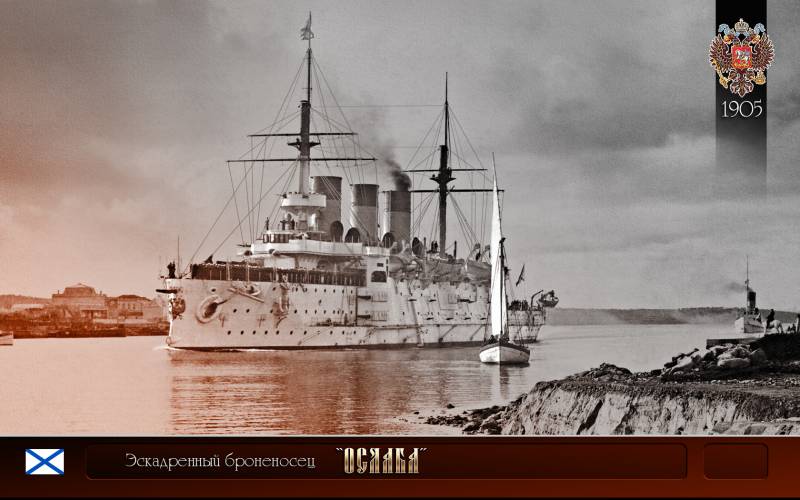
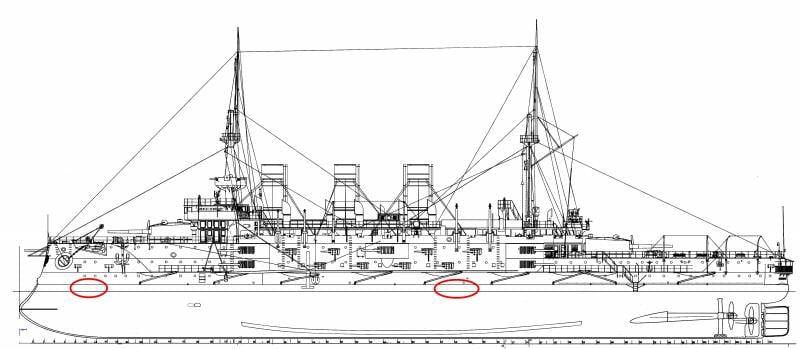
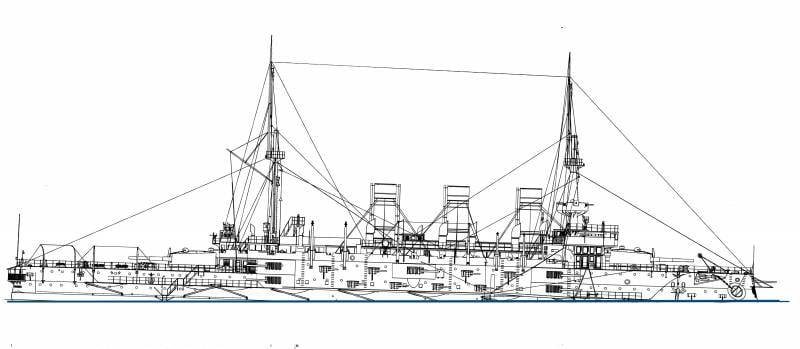
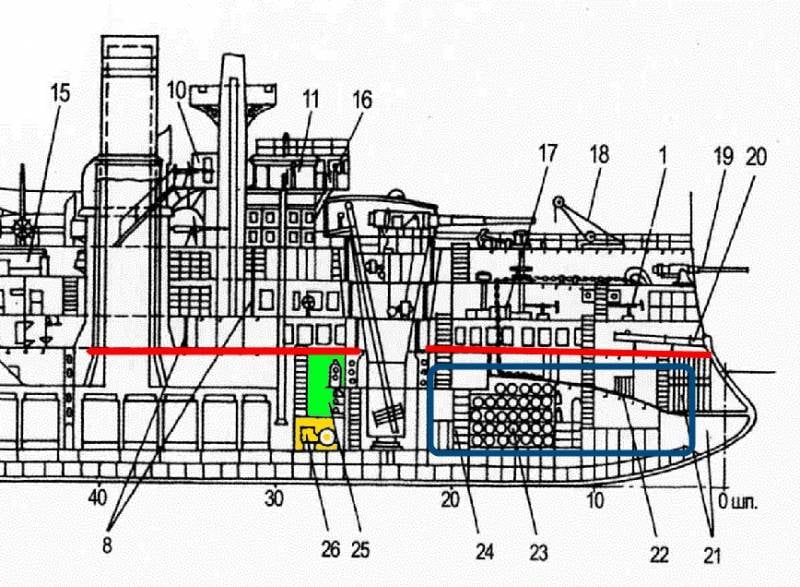
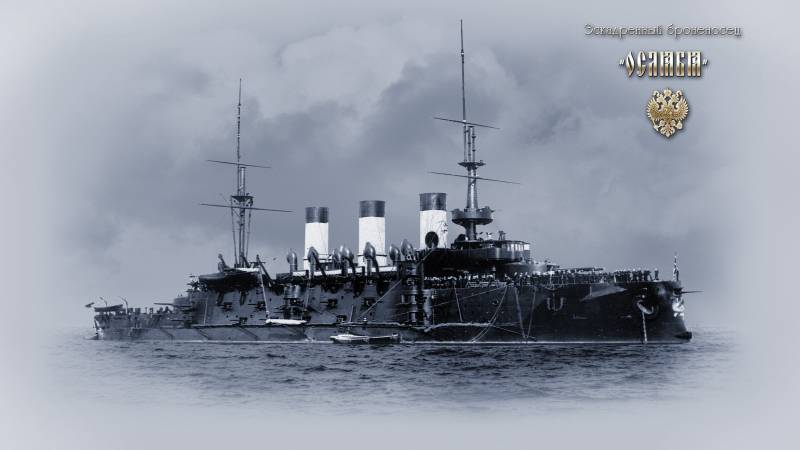
Information